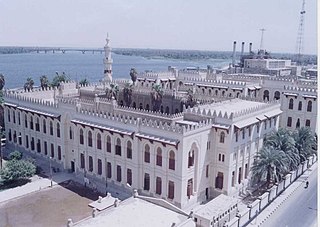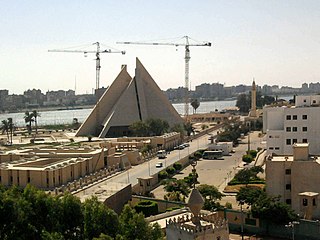
Thebes, known to the ancient Egyptians as Waset, was an ancient Egyptian city located along the Nile about 800 kilometers (500 mi) south of the Mediterranean. Its ruins lie within the modern Egyptian city of Luxor. Thebes was the main city of the fourth Upper Egyptian nome and was the capital of Egypt for long periods during the Middle Kingdom and New Kingdom eras. It was close to Nubia and the Eastern Desert, with its valuable mineral resources and trade routes. It was a religious center and the most venerated city during many periods of ancient Egyptian history. The site of Thebes includes areas on both the eastern bank of the Nile, where the temples of Karnak and Luxor stand and where the city was situated; and the western bank, where a necropolis of large private and royal cemeteries and funerary complexes can be found. In 1979, the ruins of ancient Thebes were classified by UNESCO as a World Heritage Site.

Lower Egypt is the northernmost region of Egypt, which consists of the fertile Nile Delta between Upper Egypt and the Mediterranean Sea, from El Aiyat, south of modern-day Cairo, and Dahshur. Historically, the Nile River split into seven branches of the delta in Lower Egypt. Lower Egypt was divided into nomes and began to advance as a civilization after 3600 BC. Today, it contains two major channels that flow through the delta of the Nile River – Mahmoudiyah Canal and Muways Canal.

A nomarch was a provincial governor in ancient Egypt; the country was divided into 42 provinces, called nomes. A nomarch was the government official responsible for a nome.
A nome was a territorial division in ancient Egypt.

Unut, also known as Wenut or Wenet, was a prehistoric Ancient Egyptian hare and snake goddess of fertility and new birth.

The Thebaid or Thebais was a region in ancient Egypt, comprising the 13 southernmost nomes of Upper Egypt, from Abydos to Aswan.

Wahankh Intef II was the third ruler of the Eleventh Dynasty of Egypt during the First Intermediate Period. He reigned for almost fifty years from 2112 BC to 2063 BC. His capital was located at Thebes. In his time, Egypt was split between several local dynasties. He was buried in a saff tomb at El-Tarif.

Bat is a cow goddess in Egyptian mythology who was depicted as a human face with cow ears and horns or as a woman. Evidence of the worship of Bat exists from the earliest records of the religious practices in ancient Egypt. By the time of the Middle Kingdom, after the unification of Lower Egypt and Upper Egypt, her identity and attributes were subsumed within that of the goddess Hathor, a similar goddess worshipped in another nome. The imagery of Bat persisted throughout the history of ancient Egypt on the sistrum, a sacred instrument that remained associated with religious practices.
Thinis was the capital city of pre-unification Upper Egypt. Thinis remains undiscovered but is well attested by ancient writers, including the classical historian Manetho, who cites it as the centre of the Thinite Confederacy, a tribal confederation whose leader, Menes, united Egypt and was its first pharaoh. Thinis began a steep decline in importance when the capital was relocated to Memphis, which was thought to be the first true and stable capital after the unification of Egypt by Menes. Thinis's location on the border of the competing Heracleopolitan and Theban dynasties of the First Intermediate Period and its proximity to certain oases of possible military importance ensured Thinis some continued significance in the Old and New Kingdoms. This was a brief respite and Thinis eventually lost its position as a regional administrative centre by the Roman period.

Asyut is the capital of the modern Asyut Governorate in Egypt. It was built close to the ancient city of the same name, which is situated nearby. The modern city is located at 27°11′00″N31°10′00″E, while the ancient city is located at 27°10′00″N31°08′00″E. The city is home to one of the largest Coptic Christian communities in the country.
Per Nemty, an Ancient Egyptian settlement also known in Greek as Hieracon and at the modern village of al-Atawla, on the right/eastern bank of the Nile River northeast of Assiut. It was the capital of the 12th Nome of Upper Egypt. The town was centered on the Temple of Nemty, the god Nemty being the ferryman god.

Harawî was a designated nome in the area around Coptos in Upper Egypt. Harawî was once politically important, but during the 11th Dynasty, it was overshadowed by Thebes in the nome of Waset. Another important town in the nome was Ombos, the main cult place of the deity Seth. A third important place was Iushenshen, which became capital of the nome at the very end of the Old Kingdom, at least for a certain period.
Hebenu or Alabastron was a city in ancient Egypt. It was located in Middle Egypt, or the Heptanomy, and belonged to the Hare nome (𓉆. It was the early capital of the Oryx nome (𓉇. The modern village of Zawiyat al-Amwat is built on the site where the ancient city stood.

Minya is the capital of the Minya Governorate in Upper Egypt. It is located approximately 245 km (152 mi) south of Cairo on the western bank of the Nile River, which flows north through the city.

Middle Egypt is the section of land between Lower Egypt and Upper Egypt, stretching upstream from Asyut in the south to Memphis in the north. At the time, Ancient Egypt was divided into Lower and Upper Egypt, though Middle Egypt was technically a subdivision of Upper Egypt. It was not until the 19th century that archaeologists felt the need to divide Upper Egypt in two. As a result, they coined the term "Middle Egypt" for the stretch of river between Cairo and the Qena Bend. It was also associated with a region termed "Heptanomis", generally as the district which separates the Thebaïd from the Delta.
Herwer was an ancient Egyptian town in the 16th nome in Upper Egypt. It is mentioned in several ancient inscriptions dating from the Old, Middle and New Kingdom. The main deities of the place were Khnum and Heqet, both several times called lord or lady of Herwer. Perhaps in the Middle Kingdom, the place became capital of the 16th Upper Egyptian nome. The local governor Amenemhat of that nome was indeed overseer of the priests of Khnum of Herwer. The place is often mentioned in the tombs of Beni Hasan.

The Oryx nome was one of the 42 nomoi in ancient Egypt. The Oryx nome was the 16th nome of Upper Egypt, and was named after the scimitar oryx. It was located, approximately, in the territories surrounding the modern city of Minya in Middle Egypt.

Iqer was a nome in ancient Egypt, the sixth Upper province. Its capital was Iunet, modern Denderah. The name of the nome was written with the sign of a crocodile. The reading of this sign is not certain, Iq is another option. On the white chapel of Senusret I appears a list of all Egyptian nomes. Here the goddess Hathor is called lady of Iq. Next to Iunet, where Hathor was worshipped, a place called Shabet was lying in the sixth Upper Egyptian nome, another place was Khadj. The exact locations of these towns is uncertain.













